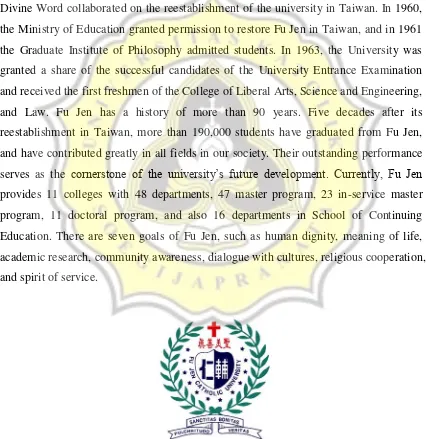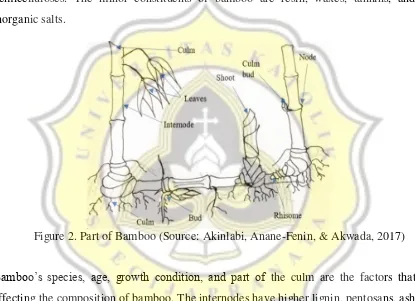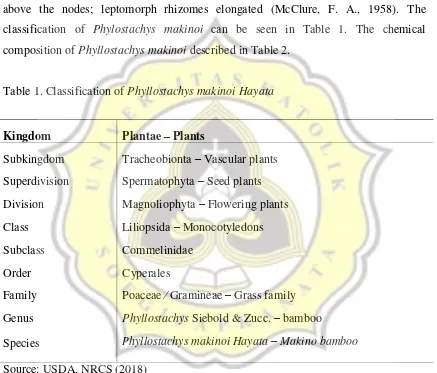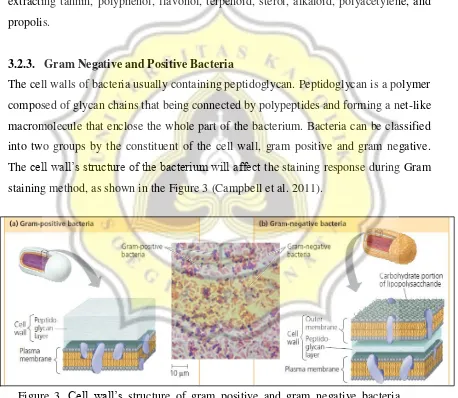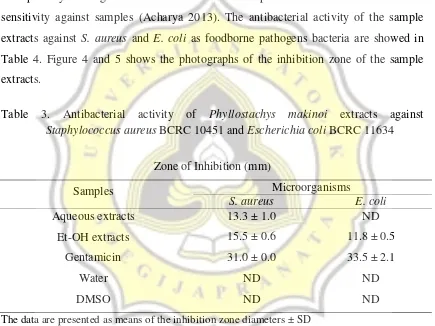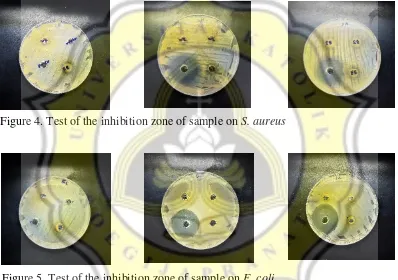ANTIBACTERIAL ACTIVITY OF BAMBOO (Phylostachys makinoi) EXTRACTS AGAINST PATHOGENIC BACTERIA
PRACTICAL TRAINING REPORT
This practical training report is submitted for the partial requirement for
Bachelor Degree
By:
Fanny Margareta Hendrawan
16.I1.0183
DEPARTMENT OF FOOD TECHNOLOGY
FACULTY OF AGRICULTURAL TECHNOLOGY
SOEGIJAPRANATA CATHOLIC UNIVERSITY
SEMARANG
ii PREFACE
Praise the Lord because by His grace and blessing, the author had the opportunity to accomplish the practical training and completed the report. The report is written based on the practical training which was done in Fu Jen Catholic University, New Taipei City, Taiwan from 4th January until 4th March 2018. During the practical training, the author did the research entitled “Antibacterial Activity of Phylostachys makinoi Extracts against Foodborne Pathogenic Bacteria”. This report was written as a requirement to acquire Bachelor Degree of Food Technology in Soegijapranata Catholic University, Semarang, Indonesia.
The author would not be able to finish this task alone and only by support and guidance given by people the author that, this report could be finished. Special thanks for:
1. Jesus Christ that always blessed, saved and guided the author in every step of practical training in Taiwan.
2. Dr. R. Probo Y. Nugrahedi STP, Msc for giving the author opportunity to join the internship program.
3. Dr. Tsung-Yu Tsai as author’s advisor for giving advices and supporting the author all the time during the practical training.
4. Dr. Ir. B. Soedarini. MP. as author’s advisor for taking care of the author during the practical training and making the report.
5. Vivian and Ruby as my mentors and to all my laboratory friends in EP403 who always give their time to help the author to do the research.
6. Dad, Mom, and brother who always support and cheers the author.
7. Angel, Eileen, Evan, Christopher, Dave, Giant, and all my friends that can’t mentioned one by one who always support and accompanied the author during the practical training.
iv
TABLE OF CONTENTS
APPROVAL PAGE ... i
PREFACE ... ii
TABLE OF CONTENTS ... iv
LIST OF TABLES... vi
LIST OF FIGURES ... vii
CHAPTER I ... 1
INTRODUCTION ... 1
1.1 Background of Practical Training ... 1
1.2 Purpose of Practical Training ... 2
1.3 Time and Place of Practical Training ... 2
CHAPTER II ... 3
INSTITUTION PROFILE ... 3
2.1. Fu Jen Catholic University ... 3
2.2. Department of Food Science ... 4
CHAPTER III ... 5
RESEARCH PROJECT ... 5
3.1. Background of Research ... 5
3.2. Literature Review ... 6
3.2.1. Phylostachys makinoi ... 6
3.2.2. Sample Extraction... 7
3.2.3. Gram Negative and Positive Bacteria ... 8
CHAPTER IV ... 10
RESEARCH METHODOLOGY ... 10
4.1. Materials ... 10
4.2. Methods ... 10
4.2.1 Bamboo Powder Extractions ... 10
4.2.1.1. Water Extraction ... 10
4.2.1.2. Ethanol Extraction ... 11
4.2.2 Antimicrobial Activity ... 11
4.2.3 Minimum Inhibitory Concentration (MIC) and Minimum Bactericidal Concentration (MBC) ... 12
CHAPTER V ... 13
v
CHAPTER VI ... 18
CONCLUSIONS & SUGESSTIONS ... 18
6.1. Conclusions ... 18
6.2. Suggestion ... 18
CHAPTER VII ... 19
vi
LIST OF TABLES
Table 1. Classification of Phyllostachys makinoiHayata ... 7 Table 2. Recoveries of water and ethanol extracts from Phyllostachys makinoi ... 13 Table 3. Antibacterial activity of Phyllostachys makinoi extracts against Staphylococcus
aureus BCRC 10451 and Escherichia coli BCRC 11634 ... 14
vii
LIST OF FIGURES
Figure 1. Logo of Fu Jen Catholic University Taiwan ... 3
Figure 2. Part of Bamboo ... 6
Figure 3.Cell wall’s structure of gram positive and gram negative bacteria ... 8
Figure 4. Test of the inhibition zone of sample on S. aureus ... 15
1 CHAPTER I INTRODUCTION
1.1Background of Practical Training
Food is primary needs of humankind, people are not expecting to just eat delicious food but also the nutritious one to support their health. The quality of the food has to be maintained during processing so the nutrition value from the food will not be degraded significantly. The appearance has to be attractive, the taste, flavor, and odor have to satisfy the consumers’ need and stimulate their appetite. Many technologies have been applied to develop the processing technique to fulfill the consumer’s demands. Products innovation will be things that interesting the consumer to try something new. Hereby, we realize the important roles of food technology in the food processing, food safety, food quality management, product development, food packaging, waste management, and many more.
Department of Food Technology, Soegijapranata Catholic University, Semarang, Indonesia sets up a training program to give opportunity to the student to improve their skill and knowledge. There are two options available for the SCU students, the first is join a food company and the second is doing internship program such as research, in one of sister universities that has collaboration with SCU. Department of Food Science, Fu Jen Catholic University, Taiwan is one of the SCU’s university partner for the internship program. Through this program, the student gains the experience not just for working on the laboratory and do the research abroad, but also experiencing cultural diversity. The soft skills that gained will be useful for him to adapt quickly once the student graduates from the university and goes into working field.
2
1.2Purpose of Practical Training
The practical training have purposes are as below:
a. To give experience on food science research in abroad with the new environment. b. To give opportunity to adapt with new circumstances and society in another country
with culture diversity.
c. To meet new friends and build international relationship network.
1.3Time and Place of Practical Training
3 CHAPTER II INSTITUTION PROFILE
2.1. Fu Jen Catholic University
Fu Jen Catholic University (FJU) is a private university located in New Taipei City, Taiwan. Fu Jen was originally established in Beijing in 1925 by the Benedictines of St. Vincent Archabbey in Latrobe as a single college named Fu Jen Academy. In 1929, Fu Jen was officially recognized as a university by the Ministry of Education. In 1959, the Chinese Regional Bishops’ Conference, the Society of Jesus, and the Society of the Divine Word collaborated on the reestablishment of the university in Taiwan. In 1960, the Ministry of Education granted permission to restore Fu Jen in Taiwan, and in 1961 the Graduate Institute of Philosophy admitted students. In 1963, the University was granted a share of the successful candidates of the University Entrance Examination and received the first freshmen of the College of Liberal Arts, Science and Engineering, and Law. Fu Jen has a history of more than 90 years. Five decades after its reestablishment in Taiwan, more than 190,000 students have graduated from Fu Jen, and have contributed greatly in all fields in our society. Their outstanding performance serves as the cornerstone of the university’s future development. Currently, Fu Jen provides 11 colleges with 48 departments, 47 master program, 23 in-service master program, 11 doctoral program, and also 16 departments in School of Continuing Education. There are seven goals of Fu Jen, such as human dignity, meaning of life, academic research, community awareness, dialogue with cultures, religious cooperation, and spirit of service.
4
2.2. Department of Food Science
5 CHAPTER III RESEARCH PROJECT
3.1. Background of Research
Food borne disease is described as the illness resulted after ingestion of contaminated food or water by pathogenic microorganisms. During anytime of food production consumption, food contamination is possible to occur, this referred to “from farm to table” (Mostafa et al. 2017). Food borne diseases can be resulted from pathogenic bacteria such as Staphylococcus aureus and Escherichiacoli. Staphylococcusaureus is capable to produce some toxins like enterotoxin-A and –D that causing abdominal pain, vomiting, and diarrhea (Tanaka et al. 2011). The existence of E. coli in food is an indicator of the enteric pathogens presence. Foods contaminated by pathogenic microorganisms usually do not show any indications, the foods do not look, taste or smell bad. Therefore, the growth of these pathogenic bacteria in food should be prevented.
Prevention of food borne pathogens is achieved by the use of preservatives. In spite of the efficiency of chemical preservatives were proven, the frequent applications of it has resulted in the accumulation of chemical residues in food and give side effects on human health (Mostafa et al. 2017). Nowadays, consumers are demanding for good quality food with safety additives agents, to minimize the side effect. Based on this condition, natural preservative is being developed with expectation to have less harmful effects. Inhibitory compounds can be found from extracting essential oils, organic acids, bacteriocins, and dried fermentation-based products (Zhang et al. 2010). Bamboo is one of the plant that has some antimicrobial properties. Different parts of bamboos have multiple biological activities such as antioxidant, scavenging oxygen radicals, protecting human being from cardiovascular disease and cancer, as well as anti-bacteria and antivirus (Tanaka et al. 2011). In this study, antibacterial agent was extracted from bamboo of Phylostachys makinoi to analyze the inhibitory activity toward Escherichia
6
3.2. Literature Review 3.2.1. Phylostachys makinoi
Bamboo is a plant belongs to grass family which grows abundantly in Asian countries and being used extensively as household utilities, building applications, and medicinal applications. Bamboo consists of cellulose fibers imbedded in a lignin matrix, therefore it is considered as a composite material. Parts of bamboo can be described as figure below (Figure 1). The bamboo’s chemical composition is almost the same with wood’s composition. The main constituents of the culm tissue are cellulose, lignin, and hemicelluloses. The minor constituents of bamboo are resin, waxes, tannins, and inorganic salts.
Bamboo’s species, age, growth condition, and part of the culm are the factors that affecting the composition of bamboo. The internodes have higher lignin, pentosans, ash, and water-soluble extractives than the nodes, but less of cellulose. The inner part of the bamboo has higher ash content than in its outer part. The ash content consists of inorganic materials such as calcium, potassium, and silica. Lignin is the second major constituents in bamboo after cellulose. Lignin in bamboo described as a macromolecular 3-dimensional polymer which belongs to the grass type and consisting three types of phenyl-propane units, there are: p-hydroxyphenyl (H), guaiacyl (G), and syringyl (S) units interconnected through biosynthetic pathways in a molar ratio of 10:68:22 (Liese and Kohl 1980). The immature bamboo culms has different lignin composition from top to the bottom. The lignin content is decreased from downward to
7
upward in the same culm during the height growth and getting constant after reaching its full size. Bamboo leaves, shavings, and shoots have many components such as flavonoids, phenolic acids, polysaccharide, anthraquinones, coumarins, and peptides. Anthraquinones and coumarins are two components that have strong antibacterial and bactericidal activities (Zhang et al. 2010). Phylostachys makinoi has some characteristics such as culms up to 60 feet long, average 25 to 45 feet; 2-3 inches diameter; woody; the colour of the internodes are pale green with purplish-brown spots above the nodes; leptomorph rhizomes elongated (McClure, F. A., 1958). The classification of Phylostachys makinoi can be seen in Table 1. The chemical composition of Phyllostachys makinoi described in Table 2.
Table 1. Classification of Phyllostachys makinoiHayata
Kingdom Plantae – Plants
Subkingdom Tracheobionta – Vascular plants Superdivision Spermatophyta – Seed plants Division Magnoliophyta – Flowering plants Class Liliopsida – Monocotyledons Subclass Commelinidae
Order Cyperales
Family Poaceae ⁄ Gramineae – Grass family Genus Phyllostachys Siebold & Zucc. – bamboo
Species Phyllostachys makinoiHayata – Makino bamboo Source: USDA, NRCS (2018)
3.2.2. Sample Extraction
8
reflux, soxhlet extraction, solid phase, and supercritical-fluid extraction (Sasidharan et al. 2011). The efficiency of extraction process is affected by the methods that being used and conditions such like temperature, time, pressure, solvent, sample amount (Rostagno et al. 2009). Like dissolve like is the basic principle of extraction therefore polarity of the desired compound should be considered when choosing type of the solvent. Water is one of polar solvent that can dissolve sugar, amino acid, saponin, tannin, lectine, terpenoid, anthocyanin, starches, and polypeptide (Gupta et al. 2012). On the other side, ethanol has characteristics as non-polar solvent that can be used for extracting tannin, polyphenol, flavonol, terpenoid, sterol, alkaloid, polyacetylene, and propolis.
3.2.3. Gram Negative and Positive Bacteria
The cell walls of bacteria usually containing peptidoglycan. Peptidoglycan is a polymer composed of glycan chains that being connected by polypeptides and forming a net-like macromolecule that enclose the whole part of the bacterium. Bacteria can be classified into two groups by the constituent of the cell wall, gram positive and gram negative. The cell wall’s structure of the bacterium will affect the staining response during Gram staining method, as shown in the Figure 3 (Campbell et al. 2011).
Firstly, samples are stained using crystal violet dye and iodine as a mordant, afterward alcohol is being used to rinse. Lastly, samples are stained with safranin. The cell walls
9
of gram positive bacteria are simpler and composed of multilayer peptidoglycan, therefore the crystal violet is trapped in the cytoplasm and does not removed by alcohol rinse. The cell walls remain stained purple so the safranin has no effect. On the other hand, gram negative bacteria have more complex structure, with lipopolysaccharides (carbohydrates bonded to lipids) as the outer membrane and the peptidoglycan layer is thinner, located between the outer membrane and the plasma membrane. Consequently, the crystal violet is easily washed out from the thin layer of peptidoglycan by the alcohol and the cell appears red from the safranin.
E. coli are non-spore forming bacteria, with a single layer of peptidoglycan inside the
periplasm. The cells structure are approximately 0.5 μm in diameter and 1.0–3.0 μm in length. E. coli belongs to facultative anaerobe bacteria and capable of growing over a wide range temperature (approximately 15–48oC) with the optimal growth in range of 37–42oC. Their pH range to grow approximately within 5.5-8.0 with neutrality at their best condition (Welch 2006). Gram negative bacteria such as Escherichia coli have some lipid constituents in their cells wall from the lipopolysaccharide that are toxic, causing fever and shock. Their cells wall structure protect them from antibiotic with interfering the entry of the drugs, for that reason gram negative bacteria be likely more resistant than the gram positive like Staphylococcus aureus (Campbell et al. 2011).
Staphylococcus aureus are non-motile, non-spore forming and be classified as
facultative anaerobes bacteria. The diameter of the cell approximately are 0.5 – 1.5 μm. The cell wall of S. aureus is made by peptidoglycan as its basic constituents. The other components are a group of phosphate-containing polymers called teichoic acids, surface proteins, exoproteins and peptidoglycan hydrolases. S. aureus are resistance to heat and show tolerant to high concentrations of salt. They are belong to coagulase positive
10 CHAPTER IV
RESEARCH METHODOLOGY
4.1. Materials
The materials that being used were bamboo powder of Phylostachys makinoi provided by Food Science Department of Fu Jen Catholic University, cultures of Staphylococcus
aureus BCRC 10451, cultures of Escherichia coli BCRC 11634, gentamicin, MHA
(Mueller Hinton Agar), MHA (Mueller Hinton Broth), ethanol, dimethylsulphoxide (DMSO), distilled water, micropipette, tips, tubes, petri dish, inoculating loop, bunsen, sterile cotton bud, sterile bottle, centrifuge bottle, centrifuge, vortex, vacuum filter, 0,22µm syringe filter, weighing scale, refrigerator, freezer, incubator, rotary evaporator, freeze dryer, shaker water bath.
4.2. Methods
4.2.1 Bamboo Powder Extractions 4.2.1.1 Water Extraction
Bamboo powders were weighed for 20 grams and put inside 500ml bottle.
As much as 250 ml of distilled water were added into the bamboo powders.
The samples were extracted with hot water at 120oC for 20 minutes.
The extracts were cooled down to the room temperature.
The supernatant of the extracts were collected and being filtered using vacuum filter.
The extracted solutions were stored in frozen temperature using freezer.
11
4.2.1.2 Ethanol Extraction
Bamboo powders were weighed for 20 grams and put inside 500ml bottle.
As much as 150 ml of 99% ethanol was added into the bamboo powders.
The samples were shaken for 48 hours using shaker water bath with speed of 200 rpm.
The samples were centrifuged at 4oC 12000 rpm for 30 minutes.
The supernatant were collected as ethanol extracts.
The ethanol content of the extracts was evaporated using rotary evaporator at 25oC.
The extracted solutions were stored in frozen temperature using freezer.
The extracted solutions were dried using freeze dryer for three days.
4.2.2 Antimicrobial Activity
Stock of water and ethanol extract were prepared as samples. As much as 0.1 gram sample of water extract would be dissolved in 1 ml of sterilized water, and for the ethanol extract DMSO were used with the same concentration. Samples were sterilized by filtration using 0.22 µm milipore filters. The antimicrobial activity was measured using agar well diffusion method. A hundred µ L (100 µ L) of suspension containing 1 x 107 each culture stock of Escherichia coli as gram negative and Sthaphylococcus
aureus as gram positive bacteria were used as inocula and spread on Mueller Hinton
12
4.2.3 Minimum Inhibitory Concentration (MIC) and Minimum Bactericidal Concentration (MBC)
13 CHAPTER V
RESULT AND DISCUSSION
Food pathogenic bacteria are causing food borne disease that resulting illness after ingestion of contaminated food or water. During anytime of food production consumption, food contamination is possible to occur, this referred to “from farm to table”. Food industry prevents food contamination and preserves the food quality by applying some synthetic chemicals preservatives. In spite of that, the chemicals preservatives used are result to give side effects to the consumers’ health. Natural preservatives are developed to be used as the alternative way of preserving food with expected to have less harmful effects. Bamboo is perennial evergreen plant which has been found to have antioxidant, antiallergic, anticancer, and antibacterial activity (Tanaka et al. 2014). In this study, Phyllostachys makinoi bamboo was freeze-dried and milled into powder. The powder was extracted using hot water and ethanol. Water and ethanol extraction then being freeze-dried and weighed to know the percent recovery. Freeze dryer is a drying method under low temperature, where the solvent and/or the suspension medium will be crystallized and subsequently sublimated from the solid phase directly into vapor (Ciurzyńska and Lenart 2011). This preservation method has advantages suchlike no heating treatment, high recovery of volatile compounds that are usually heat-sensitive components, and high yield. The results of the bamboo recoveries are listed in Table 3.
Table 2. Recoveries of water and ethanol extracts from Phyllostachys makinoi
Samples Dried extract (g) Bamboo Extracts Recoveries (%)
aqueous extracts 0.497 2.49
Et-OH extracts 0.222 0.56
14
Agar well diffusion assay was used as qualitative measurement of the inhibitory effect from bamboo extracts. Antibacterial agent diffused into agar plate and showed inhibition against growth of bacteria which represent as clear zone in the agar media. This assay was performed by measuring the clear zone diameter in the MHA media. The formula of MHA per liter of purified water are: Beef extract: 2.0 g; Acid Hydrolysate of Casein: 17.5 g; Starch: 1.5 g; Agar: 17.0 g. MH medium usually are used as antibiotic susceptibility testing (AST) because of its low concentration of sulfonamide, trimethoprim, and tetracycline inhibitors with regard to no interfere to the susceptibility testing. The clear zone diameter has positive correlation with bacteria sensitivity against samples (Acharya 2013). The antibacterial activity of the sample extracts against S. aureus and E. coli as foodborne pathogens bacteria are showed in Table 4. Figure 4 and 5 shows the photographs of the inhibition zone of the sample extracts.
Table 3. Antibacterial activity of Phyllostachys makinoi extracts against
Staphylococcus aureus BCRC 10451 and Escherichia coli BCRC 11634
Zone of Inhibition (mm)
Samples Microorganisms
S. aureus E. coli
Aqueous extracts 13.3 ± 1.0 ND
Et-OH extracts 15.5 ± 0.6 11.8 ± 0.5
Gentamicin 31.0 ± 0.0 33.5 ± 2.1
Water ND ND
DMSO ND ND
The data are presented as means of the inhibition zone diameters ± SD ND = Inhibition zone not detected
15
Gram negative bacteria be likely more resistant than the gram positive. Their cells wall structure protect them from antibiotic with interfering the entry of the drugs (Campbell et al. 2011). The diameter of the clear zone revealed that ethanol extract was more effective as an antibacterial agent than water extract. This implies that most of bioactive compound that plays a role as antibacterial agent on sample have a moderately non-polar characteristic (Salama and Marraiki 2010). Gentamicin is antibiotics that effectively prevent infection of gram negative and positive bacteria such as Escherichia
coli and Staphylococcus sp. It was used as positive control and showed the highest
antibacterial activities against both of bacteria. The inhibition mechanism of gentamicin
by preventing protein synthesis with irreversibly bind to specific protein and rRNA of the bacteria. The general recommendation concentration for cell cultured test is 50 μg/ml for eukaryotic cell culture and 15 μg/ml for prokaryotic cells. Whereas, water and DMSO were used as negative control and showed no inhibition zone against all the test strains.
Agar well diffusion assay results showed that ethanol extracts of Phyllostachys makinoi exhibited antimicrobial activity against both gram negative and positive bacteria, whilst only gram positive bacteria for the water extracts. Furthermore, minimum inhibitory
16
concentrations (MIC) and minimum bactericidal concentration (MBC) tests were determined. MIC can be defined as the lowest concentration that are needed for antibacterial agent to completely inhibit the growth of a certain bacteria, while the lowest concentration for an antibacterial agent to kill the bacteria is called MBC (Tanaka et al. 2014). A bacteriostatic drug only has ability to inhibit the growth of bacteria without kill them, while a bactericidal drug kills bacteria (Levinson 2014). The MIC and MBC of Phyllostachys makinoi extracts to be tested to the pathogenic bacteria were shown in Table 5. However, MIC and MBC test of water extracts towards
Escherichia coli were not performed owing the fact that there was no effect against the
tested gram negative bacteria.
Table 4. MIC and MBC of Phyllostachys makinoi extracts
Samples
MIC (µ g/ml) MBC (µ g/ml) Staphylococcu s aureus Escherichia coli Staphylococcus aureus Escherichia coli
Et-OH extract 8 8 32 32
Aqueous
extract 8 32
: MIC and MBC tests were not analyzed
Based on Table 5, ethanol and water extracts had the same concentration of MIC and MBC against the bacteria. The MIC of both samples were 8 µg/ml toward
Staphylococcus aureus and Escherichia coli. The minimum concentration where no
colony of the tested bacteria growth was considered as MBC. The MBC for two samples against the tested pathogens were 32 µg/ml. This results indicated that ethanol extracts effectively act as bactericide for gram negative and positive bacteria, whereas water extracts only worked for the gram positive.
17
18 CHAPTER VI
CONCLUSIONS & SUGESSTIONS
6.1. Conclusions
Water and ethanol extracts from bamboo have antibacterial activity against pathogenic bacteria.
Antibacterial agents contained in bamboo have more non-polar characteristic indicated by the ethanol extractions possessed higher antibacterial activity with wider zone of inhibition against the test strains. Water extractions could not inhibit the gram negative bacteria.
6.2. Suggestion
19 CHAPTER VII REFERENCES
Acharya, Tankeshwar. 2013. “Mueller Hinton Agar (MHA): Composition, Preparation and Uses.” 2013. https://microbeonline.com/why -mueller-hinton-agar-is-used-in-routine-antibiotic-susceptibility-testing/.
Afrin, T., T. Tsuzuki, R. K. Kanwar, and X. Wang. 2012. “The Origin of the Antibacterial Property of Bamboo.” Journal of the Textile Institute 103 (8): 844–49. https://doi.org/10.1080/00405000.2011.614742.
Akinlabi, Esther Titilayo, Kwame Anane-Fenin, and Damenortey Richard Akwada. 2017. Bamboo. https://doi.org/10.1007/978-3-319-56808-9.
Campbell, Neil A., Jane B. Reece, Lisa A. Urry, Michael L. Cain, Steven A. Wasserman, Peter V. Minorsky, and Robert B. Jackson. 2011. Biology. Biology. https://doi.org/10.1007/s13398-014-0173-7.2.
Ciurzyńska, Agnieszka, and Andrzej Lenart. 2011. “Freeze-Drying - Application in Food Processing and Biotechnology - A Review.” Polish Journal of Food and
Nutrition Sciences 61 (3): 165–71. https://doi.org/10.2478/v10222-011-0017-5.
Gupta, Ankit, Madhu Naraniwal, Vijay Kothari, Science Education, Ankit Gupta, Madhu Naraniwal, and Vijay Kothari. 2012. “Modern Extraction Methods for Preparation of Bioactive Plant Extracts.” International Journal of Applied and
Natural Sciences 1 (1): 8–26.
Harris, Llinos G., S. J. Foster, R. G. Richards, P. Lambert, D. Stickler, and A. Eley. 2002. “An Introduction to Staphylococcus Aureus, and Techniques for Identifyingand Quantifying S. Aureus Adhesins in Relation to Adhesion to Biomaterials:Review.” European Cells and Materials 4: 39–60. https://doi.org/10.22203/eCM.v004a04.
Levinson, Warren. 2014. Review of Medical Microbiology and Immunology. The Effects of Brief Mindfulness Intervention on Acute Pain Experience: An Examination of
Individual Difference. Vol. 1. https://doi.org/10.1017/CBO9781107415324.004.
Li, Mi, Yunqiao Pu, Chang Geun Yoo, and Arthur J. Ragauskas. 2016. “The Occurrence of Tricin and Its Derivatives in Plants.” Green Chem. 18 (6). Royal Society of Chemistry: 1439–54. https://doi.org/10.1039/C5GC03062E.
20
McClure, F A. 1958. Bamboos of the Genus Phyllostachys under Cultivation in the
United States. Washington, D. C.: Agricultural Research Service.
Mostafa, Ashraf A., Abdulaziz A. Al-Askar, Khalid S. Almaary, Turki M. Dawoud, Essam N. Sholkamy, and Marwah M. Bakri. 2017. “Antimicrobial Activity of Some Plant Extracts against Bacterial Strains Causing Food Poisoning Diseases.”
Saudi Journal of Biological Sciences 25 (2). King Saud University: 253–58.
https://doi.org/10.1016/j.sjbs.2017.02.004.
Rostagno, M. A., A. Villares, E. Guillamón, A. García-Lafuente, and J. A. Martínez. 2009. “Sample Preparation for the Analysis of Isoflavones from Soybeans and Soy Foods.” Journal of Chromatography A 1216 (1): 2–29. https://doi.org/10.1016/j.chroma.2008.11.035.
Salama, Hediat M H, and Najat Marraiki. 2010. “Antimicrobial Activity and Phytochemical Analyses of Polygonum Aviculare L. (Polygonaceae), Naturally Growing in Egypt.” Saudi Journal of Biological Sciences 17 (1). King Saud University: 57–63. https://doi.org/10.1016/j.sjbs.2009.12.009.
Sasidharan, S., Y. Chen, D. Saravanan, K. M. Sundram, and L. Yoga Latha. 2011. “Extraction, Isolation and Characterization of Bioactive Compounds from Plants’ Extracts.” African Journal of Traditional, Complementary and Alternative
Medicines 8 (1): 1–10. https://doi.org/10.4314/ajtcam.v8i1.60483.
Tanaka, Akinobu, Hyo Jung Kim, Shojiro Oda, Kuniyoshi Shimizu, and Ryuichiro Kondo. 2011. “Antibacterial Activity of Moso Bamboo Shoot Skin (Phyllostachys Pubescens) against Staphylococcus Aureus.” Journal of Wood Science 57 (6): 542– 44. https://doi.org/10.1007/s10086-011-1207-9.
Tanaka, Akinobu, Qinchang Zhu, Hui Tan, Hiroki Horiba, Koichiro Ohnuki, Yasuhiro Mori, Ryoko Yamauchi, et al. 2014. “Biological Activities and Phytochemical Profiles of Extracts from Different Parts of Bamboo (Phyllostachys Pubescens).”
Molecules 19 (6): 8238–60. https://doi.org/10.3390/molecules19068238.
Welch, Rodney A. 2006. “The Genus Escherichia.” The Prokaryotes: Prokaryotic
Biology and Symbiotic Associations, 60–71.
https://doi.org/10.1007/0-387-30746-X_3.
Xie, Yixi, Weijie Yang, Fen Tang, Xiaoqing Chen, and Licheng Ren. 2014. “Antibacterial Activities of Flavonoids: Structure-Activity Relationship and Mechanism.” Current Medicinal Chemistry 22 (1): 132–49. https://doi.org/10.2174/0929867321666140916113443.
21


